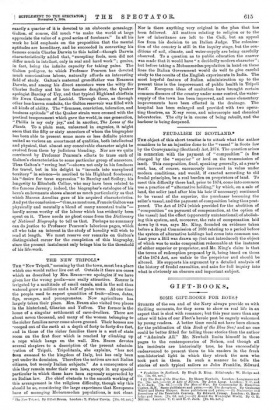GIFT-BOOKS.
SOME GIFT-BOOKS FOR BOYS.-t STORIES of the sea and of the Navy always provide us with thrilling moments, for they seem to show us real life in an aspect that is shot with romance; but this year more than any other will tales of our Fleet's heroic past be eagerly welcomed by young readers. A better time could not have been chosen for the publication of this Book of the Blue Sea,' and no one could be better fitted for telling these stories than the author of "Admirals AIL" Ur. Newbolt limits himself in these pages to the contemporaries of Nelson, and though all his incidents are historically true, he has successfully endeavoured to present them to his readers in the fresh non-historical light in which they struck the men who took part in them. In such a manner he tells the stories of such typical sailors as John Franklin, Edward
• Feudalism 'its Scotland. By Hugh B. King. Edinburgh : W. Hodge and Co. 13s. 61. net.]
(1) The Book of the Blue Sea. By Henry Newbolt. London : Long-mans and Co. 155. net.]—(2) A 1416 of Nelson. By John Lang. London : T. C. and E. C. ack. [3s. 6d.]—(3) The Man-of-War. By Commander E. Hamilton Currey, E,11. Same publishers and prioe.—(4) The Aeroplane. By Grahame White and Harry Harper. Same publishers and price.— (5) Discoveries and Inventions of the Twentieth Century. By Edward Creasy. London: G. Bout. ledgeand Bons. [711. 6d. net.]—(6) Bound the Wonderful World. By (2), H. Blitton. London: T. C. and E. 0. Jack. [M. 6d. net.] renew, and David Farragut. Ile tells us, too, once again— and we shall never be tired of hearing it—the etory of Trafalgar, making use in his narrative of the recent Report of the Admiralty Committee on the battle. Best of all perhaps are the chapters which trace the career of a Midshipman, whom Mr. Newbolt calls "Charles," who first went to sea in 1805 and served till the end of the war. Charles's letters home to his parents bear the stamp of reality upon them, and give a vivid picture of his life at sea. Here is a sentence, written on December 18th, 1806, from the Rio de la Plata, which shows how little essentials have changed in a hundred years: "We have had a great deal of Blowing Weather whilst in this River but Jack puts up with all the hardships of life Blow high or Blow low we are always cheerful and merry and ready to Chastise the Enemys of our Country, should our injured Country Bleed we will still defend it in the Flashy Medusa, while her ribs stick together, we do not mind a few Iron Dumplings—called Doe Boys by us and more commonly Duff for Breakfast." This might almost be described as the " Tipperary " spirit.—The story of Nelson's life may be read in greater detail in Mr. Lang's pages. His straight- forward narrative, together with the spirited illustrations, make up a most attractive volume. We had forgotten the story of how, when Nelson was returning across Europe in 1800, and was being everywhere received with the greatest enthusiasm, an enterprising German landlord made a large sum of money by allowing the people, at so much a head, to climb up a ladder outside a small window that commanded a view of the room in which he was sitting.—Turning from the sailors who fought to the ships they fought in, we And a far greater change. In The Man-of-War3 a continuous account is given of the evolution of the modern battleship from the sixteenth-century galeasse. A number of excellent drawings and photographs add to the interest of the work. —In the same series Mr. Grahame White and Mr. Harry Harper have produced a really admirable book upon The Aero- plane.4 The aeroplane is considered from every point of view—historical, technical, theoretical, and practical. From Leonardo da Vinci to Langley, from the Lilienthal glider to the Sykorsky multiple-engine biplane, which has carried six- teen passengers to a height of three thousand feet, the development of the flying machine is traced. There is a chapter dealing especially with the military uses of aeroplanes, while others discuss seaplanes, " lighter-than-air " machines, and the future of flying. The whole book is most clearly written, and, though not overweighted with technicalities, enters into details far enough to give the reader something more than a mere sketch of the subject.—Mr. Cressy's Discoveries and Inventions of the Twentieth Century6 is of a considerably more technical character, though to many its appeal will be no less strong on that account. It is intended to form a sequel to Robert Routledge's well- known Discoveries and Inventions of the Nineteenth Century, though its scheme is somewhat more limited. The immense development and specialization of science in the last few years makes it impossible to attempt to cover the whole ground in a single volume, and Mr. Cressy has therefore wisely confined himself to a limited number of the most important branches, but with these he deals in some detail. Thus there are chapters upon the revival of water power, upon the improvements in the various methods of transport, upon wireless telegraphy, and upon radio-active substances, to mention only a few. The book is well planned, and the large number of illustrations assists the reader to understand the descriptions.—For those who are content to view the world more from the outside we may recommend the delightful descriptions given by Miss G. E. Mitten in Round the Wonderful World.6 Egypt, the Holy Land, Burma, Japan, and the United States are among the many countries which Miss Mitton calls before us in a series of vivid sketches. Adventures exciting and amusing succeed one another in her pages, which are also enlivened by the drawings and coloured plates of Mr. A. S. Forrest, who has a strong gift for seizing a characteristic incident and conveying it to paper.















































 Previous page
Previous page